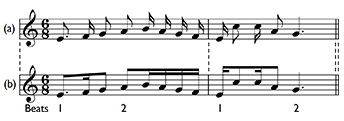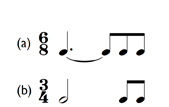3.9 Grouping and beaming notes in compound time
As with grouping notes within a single beat in simple time, beaming together quavers and semiquavers that belong to a single beat is a useful guideline to follow when grouping notes together in compound time. As you learned in the previous section, the beat in such compound time signatures as 6/8 or 9/8 is the dotted crotchet (equivalent to three quavers), so with these time signatures all quavers and semiquavers within a beat must be beamed in groups of three quavers. Example 26 shows how several notes that comprise a single beat are beamed together in 6/8 time.
Example 26

As you can see from Example 26, the extent of the beat is always shown in the beaming – each group of beamed notes adds up to three quavers (a dotted crotchet). Beaming together quavers in groups which do not add up to three quavers would suggest a different time signature where the extent of the beat is a different time value. Thus the rhythm in 6/8 in Example 27 (a) cannot be written as in Example 27 (b), because Example 27 (b) suggests 3/4 time. In Example 27 (b) the quavers are beamed together in twos rather than threes, and this signifies a crotchet beat and hence 3/4.
Example 27

When we consider time values that last for two beats rather than a single one in compound time, the ‘show the dotted beat rule’ no longer applies. For instance, time values that last for two beats in 6/8, 9/8 and 12/8 are written as Example 28 (a) rather than Example 28 (b).
Example 28

Hence, a note lasting a full bar in 6/8 is written as shown in Example 29.
Example 29
Finally, notice that a note lasting a full bar in 9/8 time is written as shown in Example 30, and in 12/8 time as in Example 31.
Example 30
Example 31
As with beaming in simple time, you can see that there is a set of conventions to follow when beaming in compound time. So, once again, take a few moments to study carefully the visual patterns involved in Examples 26 and 27.
